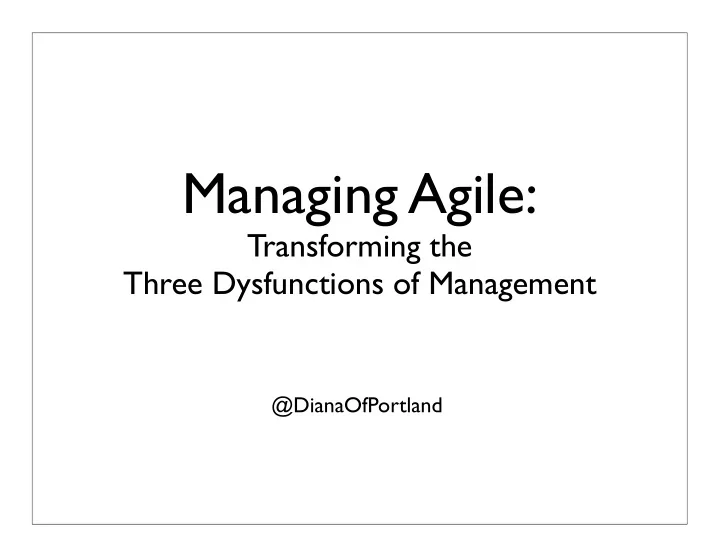

Managing Agile: Transforming the Three Dysfunctions of Management @DianaOfPortland
“We are in one of those great historical periods that occur every 200 or 300 years when people don’t understand the world anymore, and the past is not sufficient to explain the future.” Peter Drucker, 1995
So much of what we call management consists of making it difficult for people to work. Peter Drucker
budgeting controlling coordinating deciding directing evaluating influencing informing monitoring planning organizing supervising
“Things are the way they are because they got that way.” - Gerald Weinberg
Three Dysfunctional Traps: M agical Ti inkin g Ilm usion of Con ts o l F antasy of Individual Blam e 6
Trap # 1 M agical Ti inkin g
“You can fight reality and you’ll lose, but only 100% of the time." - Byron Katie
Making business decisions driven by: Hopes (or Fears) What others do What’s worked in the past What “should” work 9
Agile Springs Trap #1 Agile supplies evidence Agile highlights impediments Agile thrives on transparency and continuous improvement Agile includes more perspectives and retrospectives 10
Evidence-based Management Skills See Pfeffer & Sutton, Hard Facts, Dangerous Half- Truths & Total Nonsense: Profiting from Evidence-Based Management
Disciplined Optimism
Develop a Tracker’s View 1. Take new perspectives by noticing in new or unfamiliar ways 2. Look in the “dead zones”, the places one habitually doesn’t look 3. Balance input by not relying solely on familiar sources of information 4. Learn about the patterns one wants to see to recognize them better 5. Reduce one’s disturbance while increasing one’s area of awareness to notice beyond one’s own impact
Trap # 2 Ilm usion of Con ts o l
David Snowden “Cynefin Framework”
Paradox: the more control you’re trying to exert, the less you’ll actually have. 16
Spolsky’s 3 Drawbacks to Command & Control 1. Smart people (& teams) don’t like it. 2. There’s not enough time to do it well, so it turns into “hit and run” micro-management. 3. People closest to the work have the best information to make decisions about the work. http://www.joelonsoftware.com/items/2006/08/08.html 17
Agile Springs Trap #2 Agile emphasizes craftsmanship and self-organizing teams. Agile promotes communication, visibility & transparency in the work environment. Agile encourages feedback and continuous learning. Agile adapts to uncertainty & unpredictability. 18
The Key to Success for Organizations: A distinctive, readily identifiable culture
Where should Agile managers focus ? On creating a culture that enables “...intelligent, self-organizing, mission- focused behavior at the lowest levels of the organization.” Mary and Tom Poppendieck, Lean Software Development
Focus on Value, Flow, and People. Create a Culture of Continuous Learning and Continuous Improvement.
“Remove One Impediment a Day” Barrier Busting Business Analysis Blocking Interference Customer Advocacy 22
Trap # 3 Ti e Fantasy of I ndividual Blam e
B ∫ pe P ∫ pe
“A manager of people needs to understand that all people are different…He needs to understand that the performance of anyone is governed largely by the system that he works in – the responsibility of management.” W. Edwards Deming
“...Hold everyone accountable? Ridiculous!” - W. Edwards Deming
Blame -> CYA -> Waste
Agile Springs Trap #3 Agile has its foundation in values and principles. Agile focuses on self-organizing, cross-functional team members collectively owning the work. Agile emphasizes delivering value and discourages waste. Agile emerges from awareness of complex adaptive human systems. 28
Agile Values Collaboration Focus Commitment Learning Communication Openness Courage Quality Enjoyment Respect Feedback Simplicity 29
Agile Alliance - Purpose We support those who explore and apply Agile principles and practices to make the software industry productive, humane, and sustainable.
Prime Directive
Regardless of what we discover, we understand and truly believe that everyone did the best job they could, given what they knew at the time, their skills and abilities, the resources available, and the situation at hand. - Norman Kerth
Management’s Job: The Work Environment & Value Producing Systems
Glenda Eoyang, HSD, and the CDE Model Containers Differences Exchanges
Emergence Resilience
Focus on the Charter Monitor the Flow of Resources, Information, Material, Ideas into and out of the Team Guard against Intrusions that Impact Productivity
Within the Team Maintain a Common Vision Help the Team Reach High Performance Celebrate Small and Large Successes
Outside the Team Manage Expectations Run Interference for the Team Remove Roadblocks with other Functions Encourage Change in Systems that Undermine Teams
Support Continuous Improvement
What one thing?
About Me: Email dlarsen@futureworksconsulting.com URL http://futureworksconsulting.com Blog http://futureworksconsulting.com/blog Twitter DianaOfPortland Linked In http://www.linkedin.com/in/dianalarsenagileswd Volunteer http://agilealliance.org
Recommend
More recommend